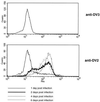Infection of human cells by dengue virus is modulated by different cell types and viral strains
- PMID: 10933688
- PMCID: PMC112311
- DOI: 10.1128/jvi.74.17.7814-7823.2000
Infection of human cells by dengue virus is modulated by different cell types and viral strains
Abstract
Although prior studies have investigated cellular infection by dengue virus (DV), many have used highly passaged strains. We have reassessed cellular infection by DV type 2 (DV2) using prototype and low-passage isolates representing genotypes from different geographic areas. We observed marked variation in the susceptibility to infection among cell types by different DV2 strains. HepG2 hepatoma cells were susceptible to infection by all DV2 strains assayed. Although the prototype strain generated higher titers of secreted virus than the low-passage isolates, this difference did not correspond to positive- or negative-strand viral RNA levels and thus may reflect variation in efficiency among DV2 isolates to translate viral proteins or package and/or secrete virus. In contrast, human foreskin fibroblasts were susceptible to the prototype and low-passage Thai isolates but not to five Nicaraguan strains tested, as reflected by the absence of accumulation of negative-strand viral RNA, viral antigen, and infectious virus. A similar pattern was observed with the antibody-dependent pathway of infection. U937 and THP-1 myeloid cells and peripheral blood monocytes were infected in the presence of enhancing antibodies by the prototype strain but not by low-passage Nicaraguan isolates. Again, the barrier appeared to be prior to negative-strand accumulation. Thus, depending on the cell type and viral isolate, blocks that limit the production of infectious virus in vitro may occur at distinct steps in the pathway of cellular infection.
Figures





References
-
- Anderson R, King A D, Innis B L. Correlation of E protein binding with cell susceptibility to dengue 4 virus infection. J Gen Virol. 1992;73:2155–2159. - PubMed
-
- Avirutnan P, Malasit P, Seliger B, Bhakdi S, Husmann M. Dengue virus infection of human endothelial cells leads to chemokine production, complement activation, and apoptosis. J Immunol. 1998;161:6338–6346. - PubMed
-
- Balmaseda A, Sandoval E, Perez L, Gutierrez C M, Harris E. Application of molecular typing techniques in the 1998 dengue epidemic in Nicaragua. Am J Trop Med Hyg. 1999;61:893–897. - PubMed
-
- Bonner S M, O'Sullivan M A. Endothelial cell monolayers as a model system to investigate dengue shock syndrome. J Virol Methods. 1998;71:159–167. - PubMed
Publication types
MeSH terms
Substances
Grants and funding
LinkOut - more resources
Full Text Sources
Other Literature Sources

